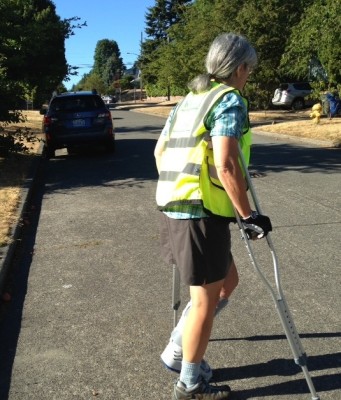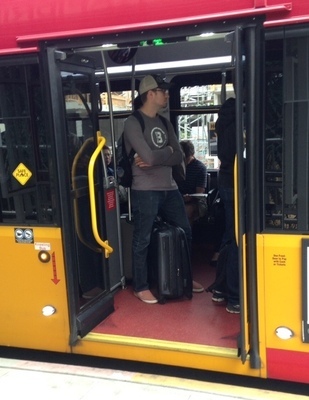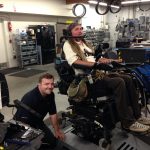 While you were taking advantage of this record setting summer to enjoy bicycling, I’ve been sidelined by a broken ankle. Instead, I have spent the past six weeks navigating my West Seattle neighborhood and the streets surrounding my workplace in Pioneer Square on a pair of crutches. It’s given me a new appreciation for the Americans With Disabilities Act of 1990 (ADA) and a more critical eye on how we design our public spaces.
While you were taking advantage of this record setting summer to enjoy bicycling, I’ve been sidelined by a broken ankle. Instead, I have spent the past six weeks navigating my West Seattle neighborhood and the streets surrounding my workplace in Pioneer Square on a pair of crutches. It’s given me a new appreciation for the Americans With Disabilities Act of 1990 (ADA) and a more critical eye on how we design our public spaces.
The ADA prohibits discrimination and ensures equal opportunity for people with disabilities in employment, government services, public accommodations, commercial facilities, and transportation. It’s because of the ADA, that many (but not all) of our street corners have curb ramps, elevators and ramps are installed in our public facilities, and much more.
My neighborhood is a walkable one and I live within five blocks of grocery stores, banks, pharmacies, a hardware store, numerous restaurants and coffee shops, the farmers market, and the transit center. I can walk to almost any service in about five minutes—until I broke my ankle. Crutching to my neighborhood destinations now takes more time and energy in order to rest my shoulders and arms, or take the least hilliest route.
Before I broke my ankle, I could bike to work in just under 30 minutes. These days, my commute involves a three-block crutch to the transit center, two bus rides, and a three-block crutch to the office. This takes me about an hour.
However, I can still make my way around thanks to the changes in the physical environment that have occurred as a result of the ADA. With some planning and prioritization, I still manage to accomplish much of what I need to do.
I’d like to share a few random observations about life on crutches:
 Crutching effectively leaves you without the use of your hands. I learned to put drinks in lidded containers with handles so I could transport them. I got into the habit of wearing clothes with pockets so I could easily carry small things with me. I don’t leave the house without a backpack.
Crutching effectively leaves you without the use of your hands. I learned to put drinks in lidded containers with handles so I could transport them. I got into the habit of wearing clothes with pockets so I could easily carry small things with me. I don’t leave the house without a backpack.
Opening heavy doors are a challenge. Without full use of my arms, I often have to open a door in stages using my crutch to keep to keep a hinged door open while I slip in or out. Automatic doors are my friends!
Kneeling transit buses rock. All transit buses should be designed this way. These are the buses that have no steps and can be lowered close to the curb to make it easier to enter and exit. Be sure to enter and exit from the front door so the driver sees you.
Stairs suck. Although I can negotiate a short flight of stairs on crutches, I feel vulnerable and awkward. And steps will stop you cold in a wheelchair.
My final take away is this: Accessible environments are people-friendly environments.
 What cyclist hasn’t used an ADA curb cut to cross a street intersection? Those trail and sidewalk ramps make crossing streets easier for parents with strollers, delivery people, kids on skateboards, and people on crutches and in wheelchairs. Those kneeling buses make boarding and exiting easier for moms with strollers, shoppers with carts, folks with wheeled luggage, and me on my crutches.
What cyclist hasn’t used an ADA curb cut to cross a street intersection? Those trail and sidewalk ramps make crossing streets easier for parents with strollers, delivery people, kids on skateboards, and people on crutches and in wheelchairs. Those kneeling buses make boarding and exiting easier for moms with strollers, shoppers with carts, folks with wheeled luggage, and me on my crutches.
Who uses those ADA accessible elevators at the LINK light rail station? It’s bike commuters, travelers carrying luggage and packages, parents with strollers, the elderly, as well as the wheelchair user. We all benefit from accessible public space.



4 Comments
I remember hearing at an ADA presentation once that “100% of the population will be disabled at some point in their life”. Unfortunately it isn’t until we experience firsthand, or through a close connection that we truly understand the barriers that exist in the built environment. Thank you, Louis, for telling your story.
When I was 39 weeks pregnant it was hard for me to walk five or six blocks. I called the city and asked about starting a program where people could sponsor a bench in the name of a loved one in the downtown core. They would be for people who could walk, but maybe needed to rest for a bit. They acknowledge my concern and that it would be especially beneficial for seniors that live downtown, however they feared it would encourage transients to sleep on them. Thus they won’t install benches downtown.
What a sad reason to avoid providing an amenity that makes the downtown more accessible and friendlier.
I’m with you 100%. Another thing I noticed while on crutches is that people don’t know how exhausted you are and don’t always get out of the way to keep your path as short as possible.
I experienced some of that as well. But I was also pleasantly surprised by the kind strangers who opened those heavy doors for me, offered to help me sit down, gave me their seat on the bus, and offered words of encouragement.